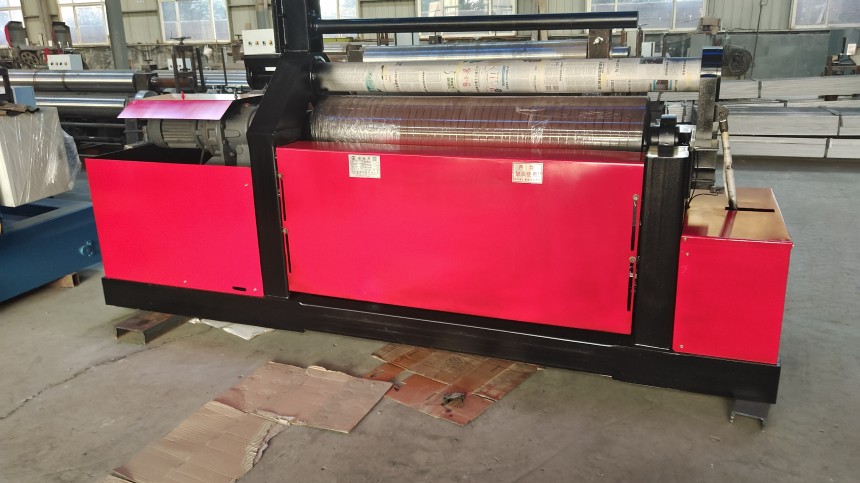

We are a professional plate rolling machine manufacturer with over 10 years of industry experience. Today, we would like to introduce the causes of excessive oil temperature in plate rolling machine hydraulic systems and measures to reduce the temperature:

The hydraulic system is the core power source of plate rolling machines, and stable control of oil temperature directly affects the working performance and service life of the equipment. In actual production, excessive hydraulic oil temperature is one of the most common faults. This article will systematically analyze the main causes of oil temperature rise and provide practical cooling solutions.
1. Analysis of the main causes of excessive oil temperature
(1)Cooling system failure
The cooling device of the hydraulic system includes an air-cooled radiator and a water cooler. When the cooling fan motor is damaged, the heat sink is blocked, or the cooling water circulation is not smooth, the heat dissipation efficiency will be significantly reduced. Especially in high-temperature environments in summer, the cooling system load increases, making it easier for insufficient heat dissipation to occur.
(2)Hydraulic oil contamination
Contaminants mixed into the oil can alter its physical properties. Contaminants such as metal particles increase internal friction in the system, while moisture reduces oil viscosity. These factors can cause abnormal increases in oil temperature. Once the oil oxidizes and deteriorates, its cooling performance also decreases significantly.
(3)Abnormal system pressure
When the relief valve is set to an excessively high pressure or malfunctions, the system remains in a high-pressure state. Prolonged overloading of the hydraulic pump generates a large amount of heat. Similarly, when hydraulic cylinders or motors experience internal leakage, the system continues to supply oil to maintain pressure, which also causes oil temperature to rise.
(4)Fuel tank design defects
A fuel tank with insufficient capacity can cause oil to circulate too quickly, resulting in insufficient cooling time. When there are no partitions inside the fuel tank, the return oil will directly impact the suction port, which is not conducive to heat dissipation. In addition, dirt accumulation on the surface of the fuel tank can also affect natural cooling efficiency.
2. Effective cooling measures
(1)Optimize cooling system maintenance
Regularly clean dust and oil stains from the surface of the radiator to ensure that the heat dissipation channels are unobstructed. Check that the cooling fan is operating normally and replace the fan motor if necessary. For water cooling systems, regularly check that the waterways are unobstructed and remove any scale deposits. In summer, consider installing temporary ventilation equipment to assist with heat dissipation.
(2)Strict oil management
Replace hydraulic oil according to the specified cycle. Thoroughly clean the oil tank before adding new oil. Regularly check the oil level and oil quality during daily operations, and deal with contamination immediately if found. It is recommended to take samples and test the oil performance every quarter. If the water content exceeds 0.1% or the contamination level exceeds the standard, the oil should be replaced immediately.
(3)Adjust system parameters
Set the system working pressure reasonably to avoid unnecessary energy loss. Check the working status of each pressure control valve to ensure that its adjustment function is normal. For hydraulic cylinders that operate frequently, consider adding an accumulator to balance system pressure fluctuations.
(4)Improve oil tank cooling conditions
Ensure the oil tank surface is clean to prevent oil residue buildup. Install cooling fins on the exterior of the oil tank to increase the heat dissipation area. For equipment operating in high-temperature environments, it is recommended to install cooling coils inside the oil tank. Additionally, ensure there is sufficient ventilation space around the oil tank.
3.Preventive Maintenance Recommendations
(1)Establish a Temperature Monitoring System
Install temperature sensors at critical points in the hydraulic system and set alarm thresholds. Operators should regularly record oil temperature data and address any abnormalities promptly. It is recommended to maintain normal operating oil temperatures within the range of 30–60°C. If temperatures exceed 70°C, the system should be shut down immediately for inspection.
(2)Enhance Daily Inspection Procedures
During shift handover, inspect the cooling system's operational status to confirm there are no abnormal noises or vibrations.
Regularly check the operating temperatures of all hydraulic components; if localized overheating is detected, promptly investigate the cause. Maintain a clean environment around the hydraulic station to prevent debris accumulation that could impair heat dissipation.
(3)Standardize operating procedures
Avoid prolonged continuous overload operation of equipment. Arrange production schedules reasonably to allow sufficient cooling time for the hydraulic system. During winter startup, perform low-speed idle operation first, and only resume normal operation once the oil temperature rises above 20°C.
The issue of excessive hydraulic oil temperature requires a comprehensive solution involving system design, daily maintenance, and proper operation. It is recommended that companies establish a comprehensive hydraulic system maintenance system and conduct regular inspections and maintenance of key components. When abnormal oil temperatures occur, systematically investigate the possible causes and take targeted measures to resolve the issue. Through preventive maintenance and scientific management, oil temperature can be effectively controlled, extending the service life of the hydraulic system and ensuring the stable operation of the rolling machine.
If you are interested in plate rolling machines, please contact us.
 Address:Room 1202, Detaitang Building, No. 118 Huaguang Road, Zhangdian District, Zibo, Shandong
Address:Room 1202, Detaitang Building, No. 118 Huaguang Road, Zhangdian District, Zibo, Shandong WhatsApp:+8615653328535
WhatsApp:+8615653328535 Wechat: +8615965331535
Wechat: +8615965331535  E-mail:zs@sdsmachinery.com
E-mail:zs@sdsmachinery.com